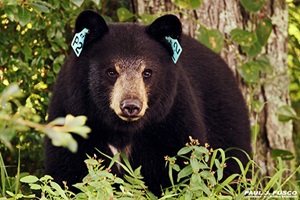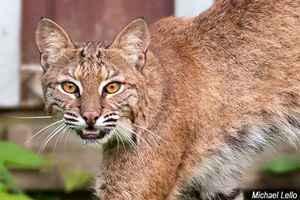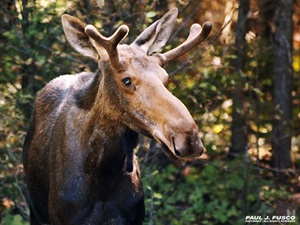Report a Wildlife Sighting
The DEEP Wildlife Division collects sighting reports of various wildlife species to help with ongoing research projects, as well as to track distribution and abundance of certain populations. You can help by reporting your observations for the wildlife species listed below.
View a map of current sightings for black bears, bobcats, and moose
 Report a Bear Sighting
Report a Bear Sighting
Select the link above to report your sighting. The Wildlife Division has been conducting a long-term study of the state's growing black bear population. Some bears have been marked with ear tags and GPS collars as part of our research. Sighting reports provide important insight about the distribution and abundance of bears throughout the state, while also providing information about any conflicts or concerns. Visit our Living with Black Bears webpage to learn more about bears in Connecticut.
As part of this long-term study, the public is also asked to report vehicle-killed bears seen along Connecticut roadways by calling 860-424-3011. (Currently, Wildlife Division offices are closed and phones are not being answered. Please report roadkills to deep.ctwildlife@ct.gov.) Examination of road-killed bears helps the Wildlife Division learn more about black bear population dynamics around the state.
 Report a Bobcat Sighting
Report a Bobcat Sighting
Select the link above to report your sighting. The Wildlife Division initiated a study of Connecticut's bobcat population in 2017. Bobcats have been live-trapped and marked with yellow ear tags and GPS collars. Sighting reports of bobcats will help biologists gain an understanding of the current state population.
The Division also collects carcasses of road-killed bobcats as part of the study. Roadkills can be reported to 860-424-3011. (Currently, Wildlife Division offices are closed and phones are not being answered. Please report roadkills to deep.ctwildlife@ct.gov.)
 Report a Moose Sighting
Report a Moose Sighting
Select the link above to report your sighting. Moose sightings in Connecticut have been monitored since the early 1990s. Annual sightings of cows with calves since 2000 confirm the establishment and expansion of a resident population. Moose sighting reports help biologists monitor the presence of this large mammal in our state. The current population is estimated at just over 100 animals. Read our Moose Fact Sheet to learn more about moose in Connecticut.
Report a Fisher Sighting
The Wildlife Division is collecting sighting reports to help monitor Connecticut's fisher population. The fisher is a large member of the Mustelidae (weasel) family that prefers large tracts of coniferous or mixed hardwood-softwood forests. Report your observations to deep.ctwildlife@ct.gov. Be sure to include the date, time, location, and any photos or video of your sighting. Please note that many people claim to have heard fisher calls that sound similar to a person "crying". In reality, those calls are most likely coming from a red fox (fishers are not very vocal). Report vehicle-killed fisher, as well, so they can be collected for research. Fisher Fact Sheet
Wild Turkey Brood Survey
Select the link above to learn more about the survey. The Wildlife Division encourages residents to participate in the annual Wild Turkey Brood Survey to help biologists estimate the average number of turkey poults (young-of-the-year) per hen statewide and to assess annual fluctuations in the turkey population. From June 1 to August 31, volunteers and Department staff record all of the hens and poults observed during normal travel.
Report Ruffed Grouse
To obtain distribution and harvest information, the Wildlife Division is asking the public to report ruffed grouse sightings and submit grouse parts. Grouse sightings may consist of actual bird observations or drumming activity. Individuals are also asked to send in grouse wings and tails from hunter harvested or road-killed birds. These items are used to determine the age and sex of grouse, which will assist in assessing productivity and harvest composition. To report grouse sightings and/or donate grouse parts, please contact Wildlife Division biologist Michael Gregonis at michael.gregonis@ct.gov or 860-418-5957.
Report Observations of Bats
Select the link above to report bat observations. Connecticut's bat species have suffered dramatically from the effects of white-nose syndrome to the point that several are now on Connecticut's List of Endangered, Threatened, and Special Concern Species. Whether you have seen a bat out during winter; one or more roosting in your bat house, barn, or eaves during summer; or even a dead bat, the Wildlife Division wants to hear about it. Submit a Public Bat Sightings Form to record your observations or email deep.batprogram@ct.gov.
Report Bald Eagle Nests
The DEEP Wildlife Division monitors nesting bald eagles in Connecticut. Almost all information about new nests and the status of existing nests comes from volunteers. This information is critical to allow the Wildlife Division to protect individual nests and Connecticut’s bald eagle population.
Report Dead Birds
If you see several dead birds (>5) in one location or notice that several birds die in the same area over the course of several days, this is a situation where testing of the dead birds may be warranted. If you observe this type of die-off, in addition to filling out this form, please call the DEEP Wildlife Division at 860-424-3011.
Content last updated on March 23, 2020.

